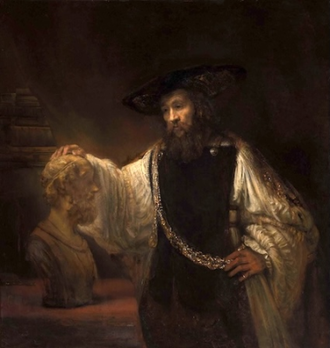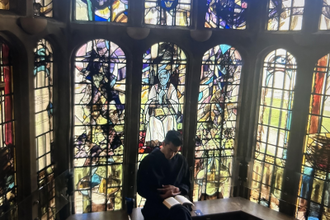Gospel in Art: What are you seeking?

Aristotle with a Bust of Homer, by Rembrandt, 1653 © Metropolitan Museum of Art, New York
Source: Christian Art
Gospel of 4 January 2025
John 1:35-42
At that time: John was standing with two of his disciples, and he looked at Jesus as he walked by and said, 'Behold, the Lamb of God!' The two disciples heard him say this, and they followed Jesus. Jesus turned and saw them following and said to them, 'What are you seeking?' And they said to him, 'Rabbi' (which means Teacher), 'where are you staying?' He said to them, 'Come and you will see.' So they came and saw where he was staying, and they stayed with him that day, for it was about the tenth hour. One of the two who heard John speak and followed Jesus was Andrew, Simon Peter's brother. He first found his own brother Simon and said to him, 'We have found the Messiah' (which means Christ). He brought him to Jesus. Jesus looked at him and said, 'You are Simon the son of John. You shall be called Cephas' (which means Peter).
Reflection on the painting
The opening words spoken by Jesus in the four Gospels vary significantly. In John's gospel, his first words are the question found in today's reading: 'What are you seeking?' Jesus addresses this question to two disciples of John the Baptist who have started to follow him. Throughout the Gospels, Jesus frequently asks questions. But probably his first question to us in John's Gospel is the most important one: What is it we really want? What is it we really seek? As we begin a new year, it is especially meaningful to hear this question, as a personal call to examine our own hearts and desires for the year to come.
Shortly after, Jesus speaks again to these disciples, offering an invitation: 'Come and see.' The first question and the invitation are deeply connected. At the start of a new year, we are encouraged to connect with our deepest longing to encounter the Lord and grow closer to Him. In doing so, we allow ourselves to see and know him as he sees and knows us. As we step into this new chapter, we can let Jesus' question and invitation guide us, inspiring us to seek Him more intentionally in the year ahead.
The act of asking questions and seeking answers is a fundamental dynamic of life. Rembrandt's Aristotle with a Bust of Homer beautifully captures this process, as Aristotle is depicted in deep contemplation, reflecting on the questions and insights posed by Homer's work. This scene evokes the timeless journey of inquiry and discovery, a journey central to the Christian life. In our faith, too, we are called to ask questions, engage in study, meditate deeply, and open our hearts to God's wisdom. Through this ongoing process, our understanding and relationship with God deepens, guiding us toward answers that illuminate our path. In our painting we see the richly clad Greek philosopher Aristotle (384-322 BCE) resting his hand pensively on a bust of Homer, the epic poet who had attained literary immortality with his Iliad and Odyssey centuries before. Aristotle wears a gold medallion with a portrait of his powerful pupil, Alexander the Great. Perhaps the philosopher is weighing his own worldly success against Homer's timeless achievement.
LINKS
Gospel in Art: https://christian.art/
Today's Reflection: https://christian.art/daily-gospel-reading/john-1-35-42-2025/


















